A voltage detector is a significant electrical safety tool that is used by electricians or utility workers who work with electrical systems & equipment. In the electrical industry, these devices play a key role in detecting the occurrence of electrical energy within conductors, electrical equipment & power lines. So they provide an effective, secure & simple method to verify whether any electrical device is de-energized or not before any work is performed. This article provides brief information on a voltage detector, its types, its working, and its applications.
What is a Voltage Detector?
A voltage detector or voltage tester is a pen-shaped testing device used to determine whether a voltage level within an electrical system is present or not. This device uses the visual (or) audio signal to alert the consumer if a voltage is detected. Some types of voltage detectors utilize lights & numbers to indicate the voltage level.
The voltage detector working principle is, that this device generally consists of a sensor or a probe that is located in contact with the circuit or electrical conductor. Once this detector detects any voltage within the circuit or device, then it alerts the user with an audible (or) visual indicator like a light or a beep. If the current that supplies is below 1 μA then it poses no risk to the user.

Voltage Detector
Voltage Detector Tester Circuit Diagram
The non-contact voltage tester circuit diagram is shown below. This is a very simple & very efficient circuit that can be designed by using simple electronic components. The main intention of this circuit is to indicate the presence of voltage within power cables, wires, lighting fixtures, electrical cords, circuit breakers, power outlets, etc. As the name suggests, this circuit doesn’t require any contact with cords, outlets, or cables. This circuit is powered by a 3V battery.
The required components to make this circuit mainly include; 2N3904 NPN Transistors – 3, Resistors – 1MΩ, 100KΩ and 220Ω Resistor, 5mm LED, CR2032 3V Battery, Small copper wire wound-like antenna, and breadboard.
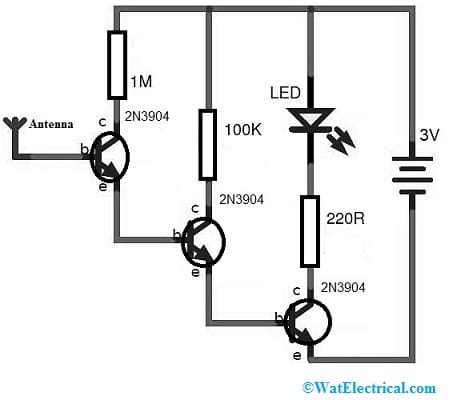
Voltage Detector Tester Circuit Diagram
Working
A small 12CM copper wire is wounded as an antenna & is simply connected to the first NPN Transistor’s base terminal. Whenever this simple antenna is placed near AC energized objects like switches & cables then it detects the magnetic field and it gets induced with a small current and hence activates the first transistor. The main principle of this circuit is to detect the varying magnetic field & indicate whether there is voltage available or not.
To detect the voltages within this circuit, here three NPN Transistors are used. Here, based on the sum of base current, the current from collector to emitter can be decided within a transistor. So the ratio of current from collector to emitter and collector to base current is called Gain. For the 2N3904 transistor, this value will be roughly 200.
If one transistor’s output is connected simply to the next transistor’s base terminal, then the net gain will be the result of individual gains. Likewise, if we include one more transistor, then the total gain will be the single transistor’s gain increased to the power of 3 (200 x 200 x 200..
Since the first transistor’s output drives the next transistor, then it gets activated. When the third transistor is activated, the LED will be turned ON which indicates the occurrence of a voltage. In addition, you can also place a small buzzer with the LED in series so that it can be enabled once this circuit notices any voltage.
The operation of this circuit is, that once the connections are made according to the above circuit diagram, the circuit is powered by connecting a battery to it. Now you can situate the circuit board within a small box through the antenna by projecting out. Locate the antenna close to switches, electrical outlets, circuit breakers, and many more. Whenever the voltage is supplied throughout these components & devices, then the LED will light up. To save the circuit battery, separate it from this circuit whenever it is not being utilized.
This noncontact voltage tester is used in several places & also close to numerous objects like cords, cables, outlets, junction boxes, switchboards, circuit breakers, and many more to notice voltage supply without any contact. This circuit is battery-operated, so one can place this in a small box to make it portable. This detector circuit is applicable in different fields like irrigation, security, entertainment, communication, environment, and many more.
Types of Voltage Detector
There are different types of voltage detectors available in the market which are discussed below.
Multi-Range Voltage Detector
The MRVD (multi-range voltage detector) is a type of direct contact voltage detector including an analog needle gauge. This detector displays phase-to-phase voltage always when a liner worker works with different phase circuits. This type of detector is utilized on a capacitive test point, overhead lines, and underground lines using an elbow adapter or bushing. A variety of MRVD devices have a switch which is very useful in choosing the proper range of voltage. So this unit is built with a tester to check whether the unit is properly working or not before & after utilization. These detector units are classic & extremely favorable among several line crews because of the ease of needle movement to notice voltage on lines.
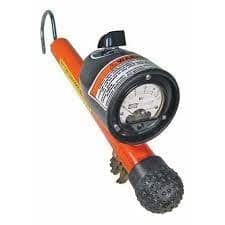
Multi-Range Voltage Detector
Auto-Ranging Voltage Indicator
The auto-ranging voltage indicator (ARVI) is a simple type of voltage detector and it doesn’t need a selector. This type has a direct contact that has a sequence of LED lights for specifying the estimated detected voltage. This detector is capable of holding a reading until it is reset, produces an audible chirp when taking a reading & after fifteen minutes of non-use, and sets an automatic sleep function. This is used on a capacitive test point, underground lines, and overhead lines with the help of an elbow adapter or bushing.
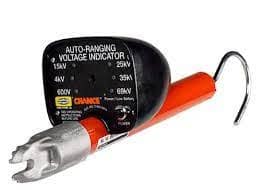
Auto-Ranging Type
Multi-Range Voltage Indicator
The multi-range voltage indicator (MRVI) is a direct contact type voltage detector including a bright LED needle gauge. This type of detector uses a stepper motor to get rid of the requirement of a selector switch. This detector unit is simply equipped with Bluetooth connectivity for displaying the reading of the meter on your smartwatch as well as a Bluetooth-enabled device. To a single MRVI, several Bluetooth-enabled bases devices can be easily connected at a time.
This detector also displays the voltage of phase-to-ground as well as the phase-to-phase voltage. This is a great alternative to utilize wherever other workers want to observe the voltage supply on the line (or) for training purposes. This detector can be used on underground, overhead lines, or a capacitive test point using a bushing (or) elbow adapter. It can also be utilized in verifying the voltage condition before placing temporary protective grounds above the line.
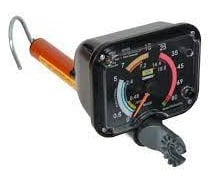
Multi-Range Voltage Indicator
Proximity Voltage Indicator
A proximity voltage indicator or PVI is similar to the ARVI and it includes a set of LED lights that specify the approximate detected voltage. This type of voltage detector is used on capacitive test points & overhead lines. This detector is strong & also available with accidental brush contact through energized components. This device is very helpful for customers who do not let energized lines be stroked until it has been checked that they are de-energized.

Proximity Voltage Indicator
Pen-style Voltage Detector
Pen-style or volt stick is a type of voltage detector that is a small, easy-to-use, and portable indicator. This detector helps in detecting voltages from a few volts to several hundred volts. These detectors provide simple and accurate testing for the occurrence of voltage. So these are used frequently by electricians, technicians & other professionals.

Pen-style Type
High-frequency (HF) AC Voltage Detector
This HF voltage detector uses a Tesla coil to generate high voltages. This detector is simply powered by a mains supply & it detects voltage over 50,000 V. In this detector, a blue brush discharge is observed at approximately an electrode throughout the operation. This discharge will transform into a white spark whenever a fault is noticed. The main drawback of this type of detector is the capacitive loss effect.
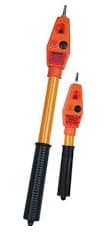
High-frequency AC Voltage Detector
Low-frequency (LF) AC Voltage Detector
This kind of voltage detector utilizes transformers to increase the mains voltage to the preferred level. These devices are larger and also capable in delivering surplus amounts of voltage. But, this detector’s output is low-frequency AC voltage. So this kind of detector displays troubles like high-frequency AC voltage.
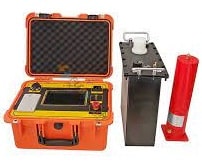
Low-frequency AC Voltage Detector
Pulsed DC Voltage Detector
This voltage detector is powered by a battery and is lightweight. This detector works on the capacitor charging principle which means a capacitor can be charged up to 400 V & discharged into a higher voltage coil for generating a high voltage pulse for a small period.
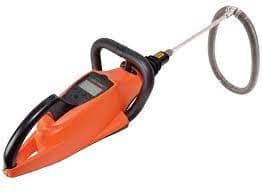
Pulsed DC Voltage Detector
Continuous DC Voltage Detector
This voltage detector is a portable device and is battery-powered. The output provided by this device ranges from hundred to 40,000 V. This detector operates on the principle that the battery activates a high-frequency oscillator that changes the voltage of the battery from 12 V DC to a maximum AC voltage.

Continuous DC
Voltage Detector Vs Multimeter
The difference between a voltage detector Vs multimeter includes the following.
Voltage Detector | Multimeter |
| A voltage detector is an electrical testing instrument used for checking whether an electric charge within an electric circuit is available or not. | A multimeter is a typical measuring instrument that is used to measure various electrical quantities within a circuit. |
| It is also known as a voltage tester. | It is also known as a volt-ohm-milliammeter or VOM. |
| These are available in different types like Multi-Range voltage detectors, auto-ranging voltage indicators, multi-range voltage indicators & proximity voltage indicators. | These are available in two types; analog and digital. |
| It functions as a detector only for electricity within a circuit (or) component. | It can function as an ammeter, frequency meter, voltmeter, ohmmeter, etc. |
| Its design is simple. | Its design is complex. |
| Its size is compact and available in pen size. | Its size is bigger and available in palm-top shape. |
| These are available at less cost. | These are expensive. |
| Voltage tester does not provide its measurement value because it detects only the electric charge presence & absence within the circuit. | The multimeter provides the measurement value within the normal units. |
| This detector is utilized in electrical & electronic testing to verify the presence & absence of electricity within a circuit. | This instrument is used in electrical testing & troubleshooting. These are used to measure the electrical quantities values like resistance, current, voltage, etc. |
Voltage Detector Hs Code
HS Code (Harmonized System code) is normally used in the goods export process. So Harmonized System (HS) is a consistent numerical technique for classifying traded products. The detector with HS Code 90303390 was imported from many countries, so its average import price for a voltage detector with this HS code was $60.88. The largest exporter was the UK with 65.48% of the total imports. The second largest exporter was the United States with a total of 16.10% imports under HS Code 90303390. There are 135 voltage detector exporters and 179 voltage detector importers according to the information received from US Customs Department
Advantages
The advantages of voltage detectors include the following.
- These devices avoid accidental contact through live electrical circuits or conductors and protect electrical workers from electrocution or electrical shock.
- These detectors help in identifying faulty circuits or components and save more time as well as money on repairs & troubleshooting.
- Its usage is very simple & portable in many cases, making it a suitable tool for troubleshooting & electrical testing.
- These are available in small size and low cost.
Applications
The uses or applications of voltage detectors include the following.
- This is used in the electrical industry for various purposes like electrical equipment testing, troubleshooting, conducting regular maintenance & recognizing electrical hazards.
- These detectors are very helpful in checking the live voltage occurrence on AC circuits, switches & electrical outlets before functioning on them.
- This device determines the occurrence or lack of an electrical charge within an object.
- These are used for monitoring battery voltage.
- Brown-out safety of the electrical system.
- Level discrimination.
- Switching circuit within battery back-up.
- Reset of microprocessor.
- This is used to check for the presence or absence of voltage on high & medium switchgear, overhead lines or transformers.
These are used in an extensive range of applications which range from house wiring to industrialized electrical systems.
How is Voltage Detected?
The voltage (or) more properly the Electric Field generated is detected with the Capacitive Coupling principle.
Can a Multimeter be used as a Voltage Detector?
Most modern multimeters can be used as non-contact voltage detectors because they have a setting to allows them to detect the electric field presence without any physical contact through a conductor.
Why Voltmeter or Multimeter Does Not Give a More Accurate Reading of Voltage?
A multimeter (or) voltmeter does not give accurate voltage readings due to the precision of the Instrument so it affects the precision of the reading.
Does a Voltmeter Measure Potential Difference?
Yes, a voltmeter can measure the potential difference between two points by connecting in parallel to the electric circuit.
What is the use of a Voltage Detector?
A voltage detector is an inexpensive and quick system to verify for the occurrence of live voltage on electrical circuits, outlets & switches before working on them.
Thus, this is an overview of a voltage detector test light or voltage tester, its types, circuit working, differences, HS code, advantages, and applications. These detectors are significant tools mainly in the electrical industry and they can be used to detect the occurrence of electrical energy within conductors, electrical equipment & power lines. These detectors provide a very effective, safe, and simple method to verify whether any electrical equipment is de-energized before any work can be performed. Here is a question for you, what is an earth tester?